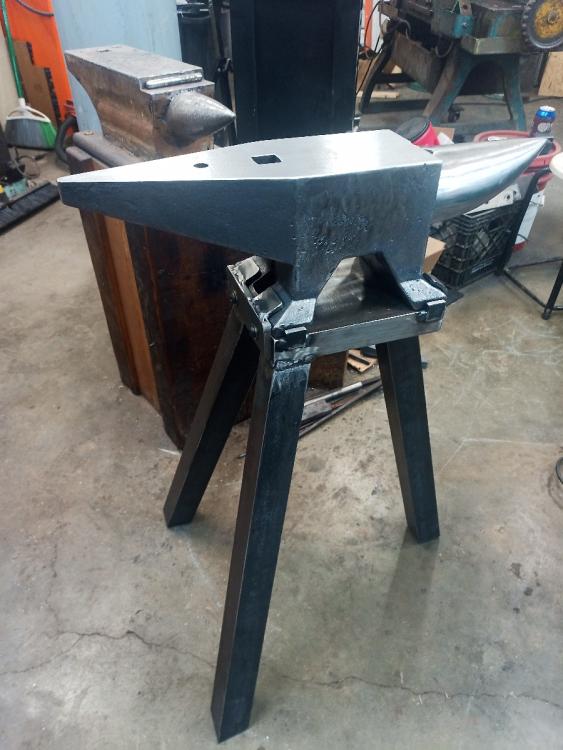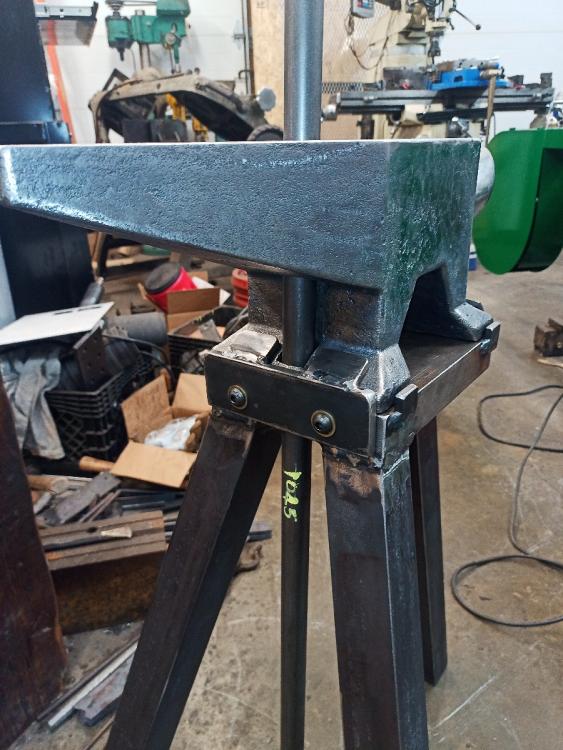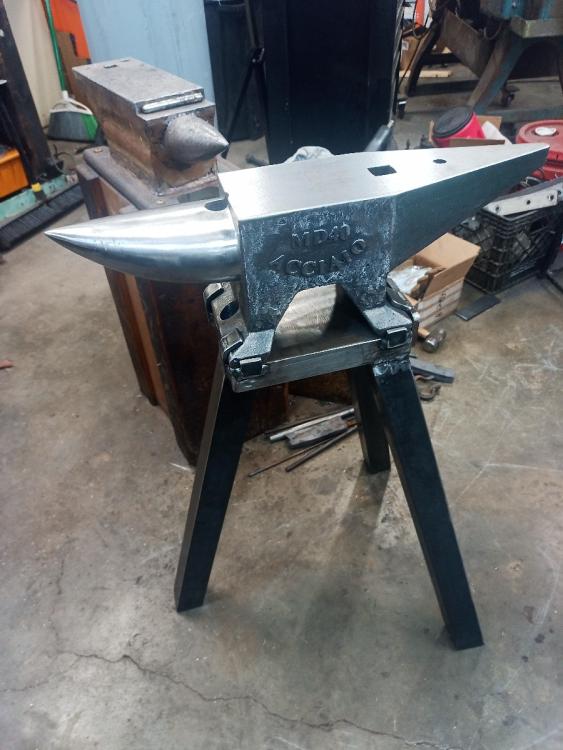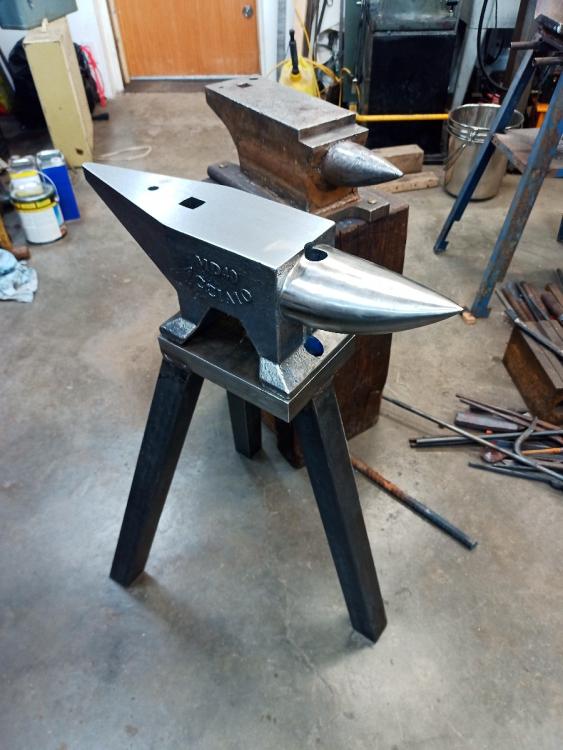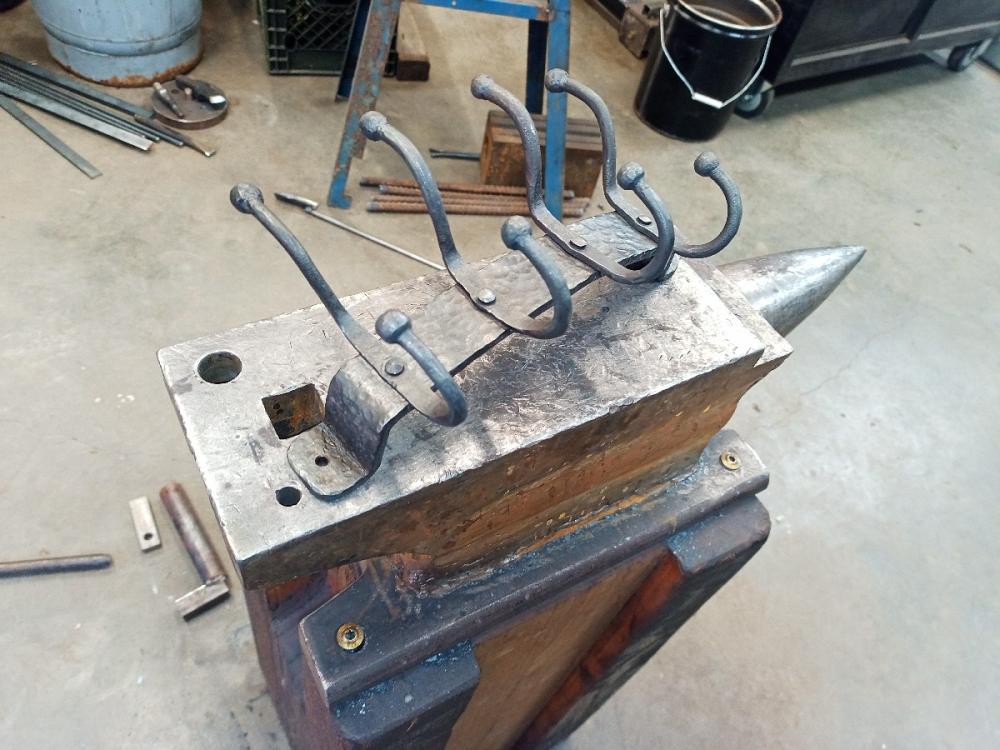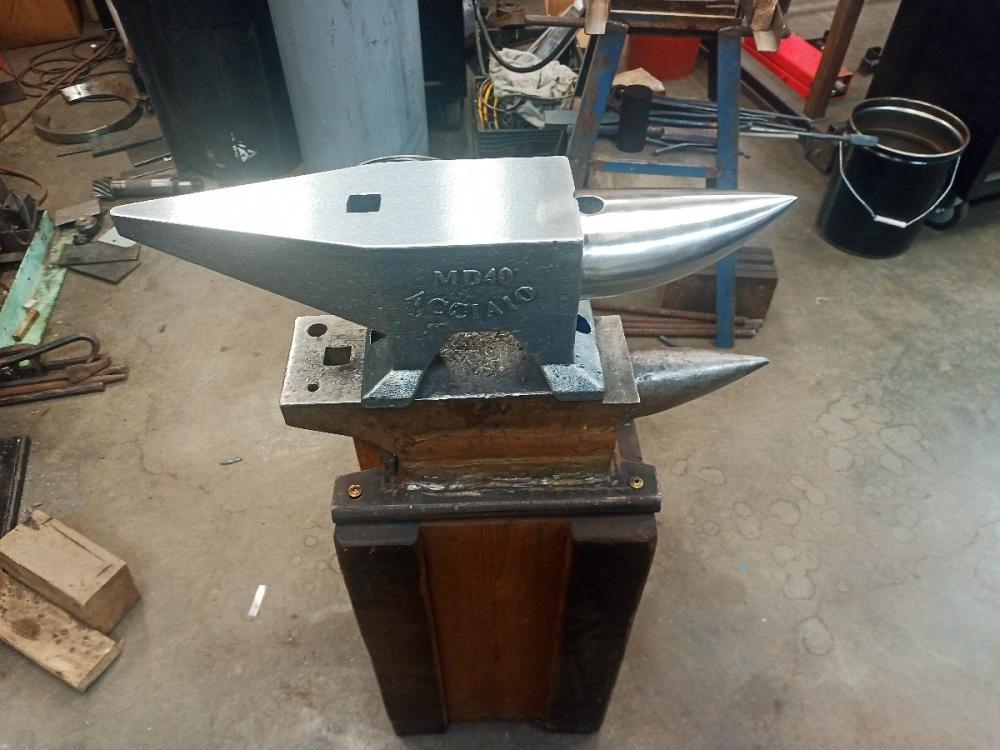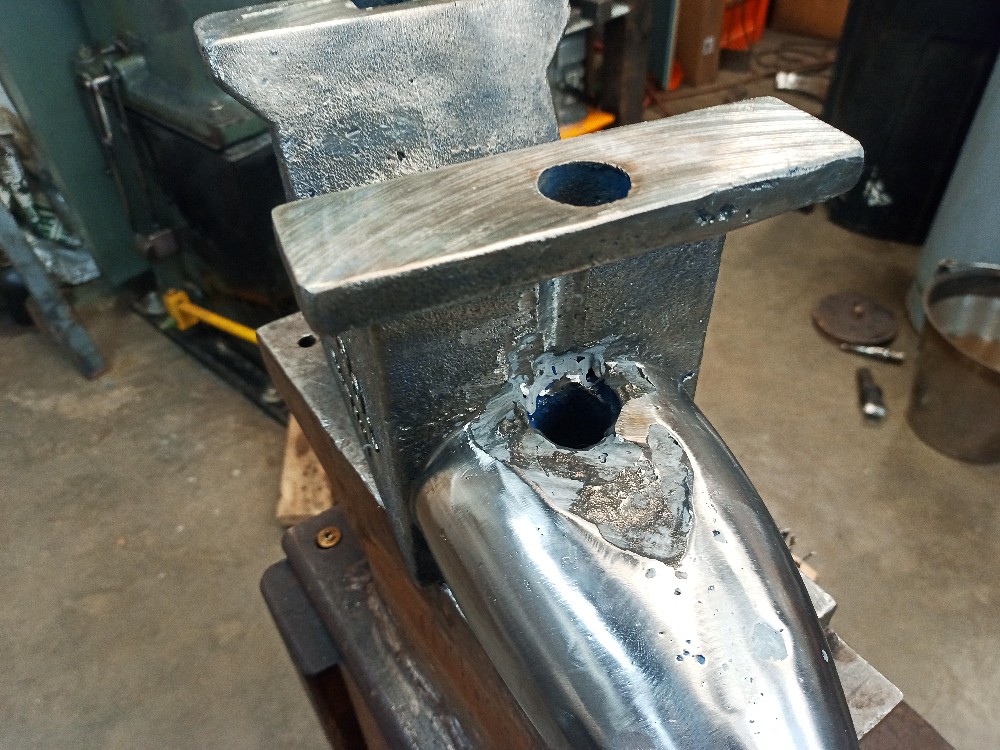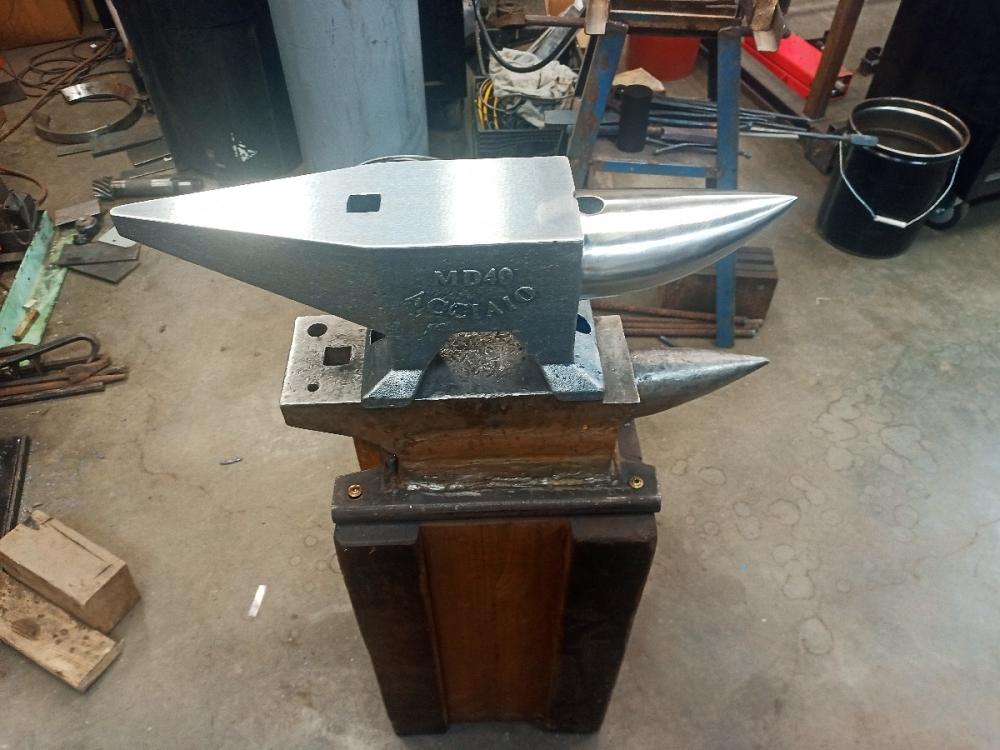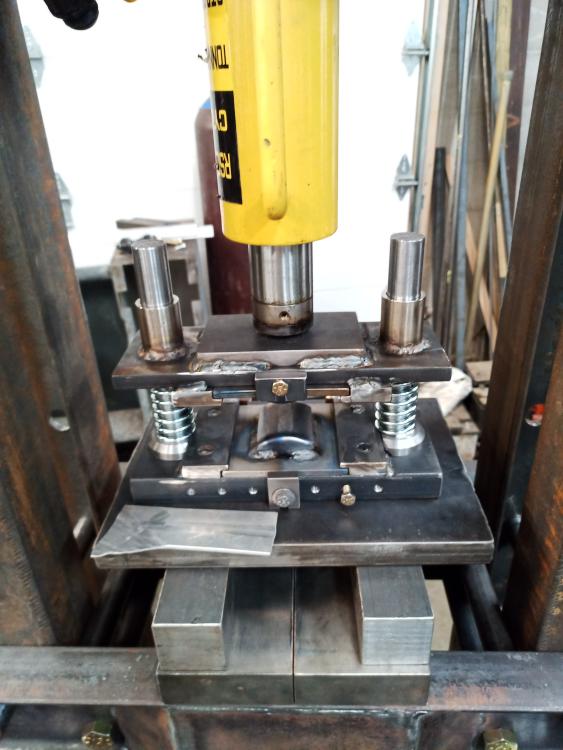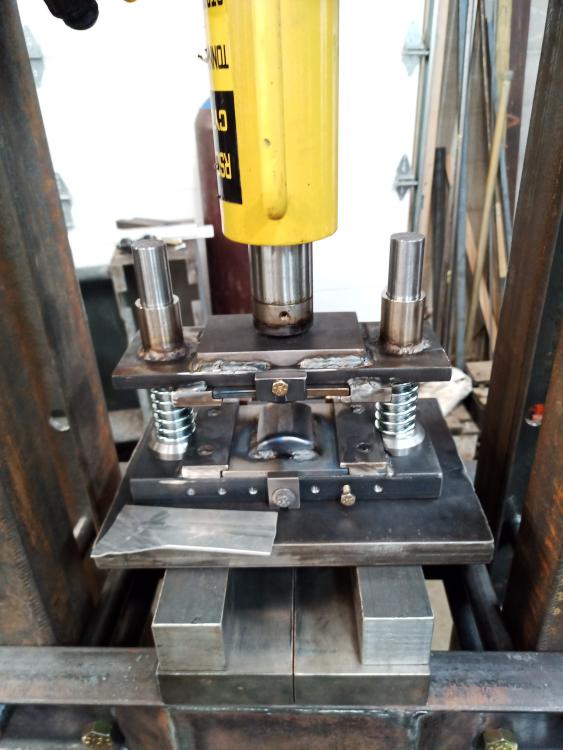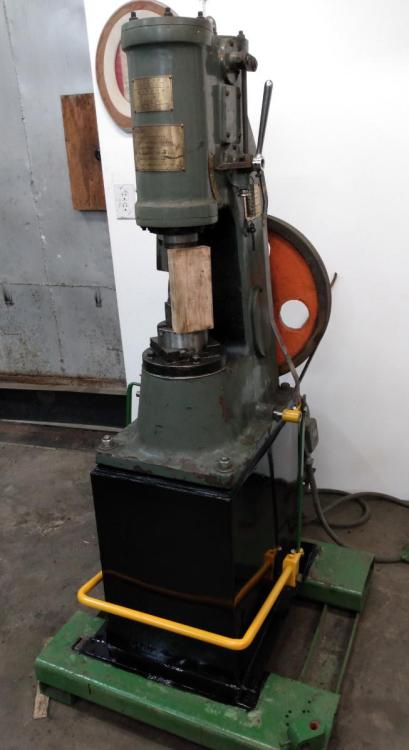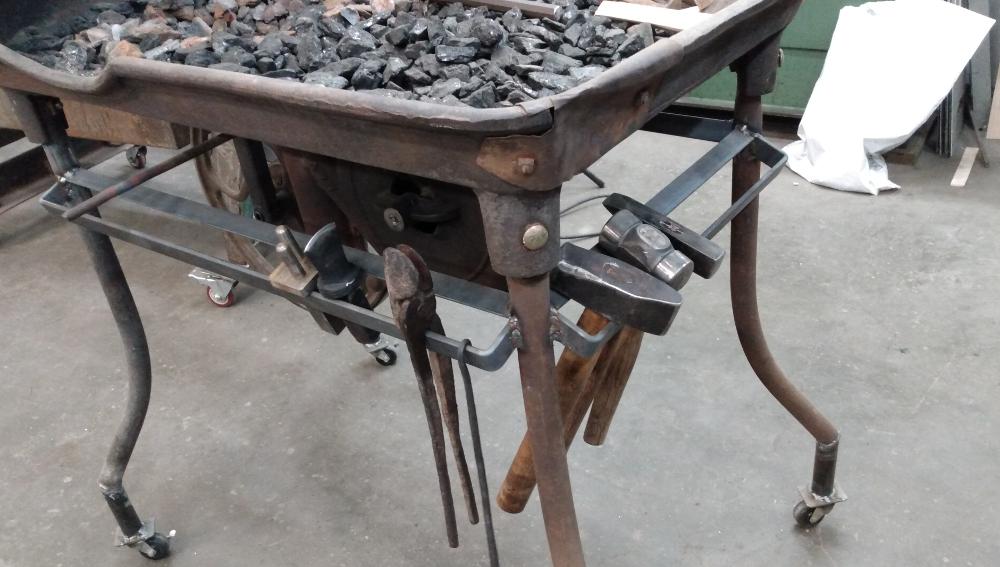-
Posts
79 -
Joined
-
Last visited
Content Type
Profiles
Forums
Articles
Gallery
Downloads
Events
Everything posted by Vinito
-
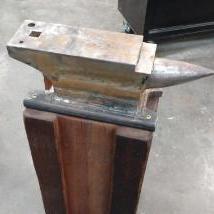
Yet another Acciaio anvil - hacking, base build, using
Vinito replied to Vinito's topic in Anvils, Swage Blocks, and Mandrels
Thanks. I was thinking the same thing regarding the welds. With that in mind, I did do a three-pass fillet on the legs which I'm hoping will help keep it beefy so it won't crack, but thanks for the tip - I will check those welds from time to time. The ring was loud and prominent just sitting on a table, but clamping it down to the base mitigated it quite a bit. I do agree that some caulk or RTV or the like at least won't hurt and it might help the ring a little. I did find that a magnet on either horn pretty much eliminates the ring. I guess that means it's the horns that are vibrating now. I will find a dedicated magnet the right size and type eventually (just haven't yet) which will stay with the anvil, but even if it falls off or something, what ring occurs without the magnet isn't too bad. It's certainly not the loud, painful ring it had before mounting it to the base. Oh yeah, I did kiss the feet just a little with a face mill to flatten it out a bit. The manufacturer milled it, but it was extremely rough and it had a bit of rock to it which my face pass flattened out. That wouldn't matter if mounting to a stump or the like, but since mine is a flat steel plate, a flat plane on the feet I figure will just help it seat solid as possible. It seems to have worked I guess. By the way, I considered (along with a bunch of other bad ideas) filling the gap between the legs with big hunks of steel. There are several reasons that isn't a good move. But now that I've seen it assembled, it occurred to me that I can make some lemonade here. I kinda like the idea that the gap makes a little shelf I can lay punches or hot steel or whatever. Anyway, turns out I think I'll like having that gap there after all. -
I picked this anvil up a while back but then got busy with other stuff so the smithy took a back burner. But last evening I finally got the base I made for it functional and got a chance to try it out first time. Now I know what the most of you already do in that a hardened top makes all the difference. Compared to the mild steel anvil I made a couple years (behind the Acciaio in photos below) ago and have been using ever since, this little cheap import just bows it away. The rebound thing is a drastically different and improved feel to the hammer hand. You can really tell you're doing work when the anvil surface is higher quality. Yeah I know - duh. Anyways, I'm really happy how this turned out so far. I'll paint the base and at some point I'll add a few hanger type things underneath. But I think I'm not going to go too wild on that because the thing is kinda mobile now and that's appealing. The clamp holding the anvil to the base is extremely simple so segregating the two is quick & easy in case I want to load it into the truck. Otherwise the two combined are just to heavy, at least for one guy. The base is made from 1-1/2" thick plate on the top and the legs are 2" square solid bar, so it's a fair bit of mass underneath the anvil. I drilled a clearance hole under the hardie hole in the base so it's a pass-through, which I've found to be quite useful in the past. My scale measures the anvil to be 86# (39Kg) and the base (so far) is 113# (51Kg). It will be slightly but not significantly heavier after I add a small hammer/tong rack of some kind. Just a couple hammers/tongs. I want to use it for a while and let it tell me what I want to add to it rather than rely on my inexperienced guesses to stick something on it now. I figure for a kind of mobile anvil like this, a separate utility table build for a larger collection of that stuff will be more practical and useful, can move it wherever is most convenient, and leaves more clearance all around the anvil. So my take on the design of the anvil is that the solutions for "fixing" the goofy round hole are too sketchy or risky to bother. I'll just leave it there and maybe use it for some odd task now & then. But I wanted a pritchel hole so I dug out a high-quality carbide drill (around 9/16") and drilled one. That went well, but if you're so inclined, don't try this with anything but carbide. This will indeed be useful in contrast to Acciaio foolishment. I cleaned up the hardie to fit 1" which was pretty much just cleaning up the casting bumps. Dressed the edges some and also put a few minutes into dressing the sides of the anvil as well which I kind of like the look of (appears odd in the photos, but much better in-person) and makes for a little smoother finish in the event I'm kind of working off the sides, i.e. bending a 90° or something. In the process, I went ahead and ground off the lettering from one side since it didn't need to be there twice, removes possible interference, and it's not like anybody is "proud" of these anvils and considers the lettering to be valuable or anything. Anyways, let me know what you think. I really like this thing so far - quite a bit more than I expected to. Pleasant surprise.
-

What did you do in the shop today?
Vinito replied to Mark Ling's topic in Blacksmithing, General Discussion
After sitting for forever, I finally started making the base for my 40Kg Acciaio anvil. It's solid 2" square legs and a 1-1/2" solid plate pulling it together at the top - because I wanted some serious mass in the base too. Turns out the base is heavier than the anvil and I'm not even done with it yet obviously. I also drilled a pritchel hole into it. I had a carbide drill (roughly 9/16") so I figured that might do just fine. Just spin it slow and keep it lubed and it got through the hardened top layer, which incidentally was somewhere around 1/8". Once through that, it was just a bunch of peck drills and blowing the chips away. Anyway, I think I'll like that hack! I've seen some pretty good ideas for dealing with the other round hole, but none of them seemed all that appealing to me, mostly because of the processes during and not because of the result. This seemed easy, and it was since I already had the suitable drill bit. Just a little more work and the anvil will finally be ready for its first real run. Behind it is the anvil I built a year or so ago which has served me well for this beginner. It's heavier but about the same size as you see, but mild steel. Looking forward to comparing! -

What did you do in the shop today?
Vinito replied to Mark Ling's topic in Blacksmithing, General Discussion
After not being able to forge for several months due to elbow surgery, I've finally got to the point where I can start learning how to hammer some steel a little lately. I'm a beginner so take it easy on me. I thought I'd whip up an accessory hanger thing as a little gift for my brother. He lives in a house that has a long history with horses and such, so anything blacksmith he's kind of a fan, so even though this is a little rough, he'll like it a lot. (well OK, some of the "rough" is because I textured the strap some, but that's not what I'm talking about) I did cheat just a little by adding a tiny tack on a hidden corner of the hooks because I'm certain that a single rivet is a recipe for coming loose and spinning eventually, at least the way I do it. -
I waited too long so couldn't edit, but what I meant above when I said "mine weighs in at 130lbs." I meant the one I made, i.e. the one Acciaio is setting on. The MD40 Acciaio obviously doesn't weigh that much. Maybe obvious, but didn't seem clear when I re-read it.
-
This will be my last hijacking of Arkans's thread, but thought adding some feedback on these Acciaio anvils from Vevor might help posterity? By the way, we all assume these are made "in the same factory in China", but I read the other day someone claiming these are cast somewhere in the Czech republic. Anyone else ever hear that? anyway... Stripping the paint for a close look at the casting reveals that it's not quite as good as I thought, but still pretty good. The area under the arch has the typical filler but of course that doesn't matter at all. Plus on the bottom of the horn under the round hole has a substantial void, but also somewhere between little and zero practical consequence. Otherwise my vote is a positive. I slid a curved file over the top and it didn't want to scratch it (pretty much just skated) and on the horn it only wanted to grip it a little, so I wouldn't say the horn is "soft" exactly, just not as hard as the top. Nothing new here, just reiteration. Me being a machinist, I wouldn't say the top has a great finish. It's flat and has been ground, but it wasn't done well and has a subtle texture that might transfer to your steel depending. But most of the time you wouldn't notice. I have access to a nice surface grinder and I might just clean that up. But honestly I'm just nitpicking and doubt I'll bother messing with it even though I could do it pretty easily, if that tells you anything. It's pretty good even if I wouldn't say it's "great". couple of quick pics in case the data is useful for others. Probably a half-hour with wire brush & abrasives.
-
Last year I built an anvil from chunks of steel. It has served this beginner pretty well but the top surface is only mild steel and the deep gouges & dents are beginning to be a problem, at least in how I feel about it. I saw these 88lb Vevor/Acciaio on eBay the other day for cheaper than I've ever seen them, so decided to pull the trigger. I'm still a beginner and these are still aimed at my demographic, so probably a pretty good fit. It arrived this morning. Some time with wire brush & abrasives converted into something I don't mind looking at. Also, I was quite surprised that less than 5 minutes with a narrow belt air grinder is all it took to fit the hardy hole for my 1" tools (the Vevor site specs the hardy hole at .9 inches (22mm) so I expected that to be more work) Here it is sitting on the one I made last year. FYI mine weighs in at 130lbs. I think the "missing" mass between the arch on the Vevor could make a significant difference, but I'm gonna try it out for a while before I start getting goofy with it.
-
I was prepared with apparati for catching the toss, but pleasantly surprised to discover that when I woke up, they had already delivered it to my porch. I reviewed the recorded video and it showed a little bitty feller just carrying it across the yard and fairly gently setting it down. Also, note that today is Sunday. For my address anyway, Fedex has a history with most deliveries of the tracking saying that it's "out for delivery" only to update the tracking late evening to say that it's been delayed, so color me amazed. Also, a cursory look tells me that the quality of the casting isn't bad at all. I'll check it out closer in the coming days. So far, so good
-
This hit me kinda funny... Tracking my anvil progress (Fedex - uuugh) and predictably, it got hung up yesterday and it's officially delayed. How much you wanna bet the reason for the delay is that the truck turned left or something and it shot sideways out the flimsy Vevor cardboard box, so Fedex now has to look around for their dusty can of zip-ties and slap a label tag to one of the anvil's holes? I dunno, but after watching a few videos reviews, I can't not see this like a little Keystone Cops movie in my head and it makes me giggle a little.
-
Yes, much easier and also cheaper, but that's what I meant. I guess I didn't explain it well, but all I meant by "a bunch of short beads" is that I would weld the chunks to the arch with short beads and that it will surely still take a bunch of them before the chunks are firmly affixed and solid. I was trying to emphasize that short beads with cool-off breaks in between would hardly raise the temp up very much at all as I want to take zero chance of drawing down what little hardness is provided in the top face. I think I'm going to go ahead and count on adding the mass partly because I've never heard anyone complain about an anvil being too heavy, but also because I fully intend to "fix" the thing that bothers me the most about these anvils, namely the round hole not being a functional pritchel. So while I'm at it, why not add some significant mass right under the heart of the sweet spot? Can I point out the elephant in the room? This offset round "pritchel" thing could easily be addressed by whomever is casting these things with a quarter pound more steel and a slight tweak of the form they're using and every customer would heartily applaud the move. Why do they keep cranking these things out like this? They've even added more sizes over the years, one after the other, and simply scaled this continued goofiness. Are they that isolated from feedback that the word never reaches someone there who could tweak the foundry pattern? Seems like a no-brainer! People are strange Edit to add: You (George) may very well be correct about maybe correcting with a solid base instead. I feel like 88lb. is going to be light for what I want to do, but I think I will do as you suggest and try it out first. And before welding mass to the arch, maybe set the feet of the anvil atop a big chunk of steel mass and see if that makes it good enough instead. Maybe I'll do both! I've seen the importance of anvil/base combination mentioned here several times and I still succumbed to forgetting consideration of the base. Thanks for the reminder
-
I guess I'm joining the Vevor anvil club too. An ebay seller had the 88lb ones for about $103 which is the best I've seen in years. I plan to do some kind of build-up or mill & plug kind of operation on the round hole (i.e. make it a useful pritchel) and was thinking it wouldn't hurt to weld a bunch of steel in the arched void thing between the feet to add some mass. I'll just take my time with the welding so it's a bunch of short beads with cooling breaks in-between so it won't migrate significant heat into the anvil - certainly won't heat up the top face, which is the only thing hardened on these things anyway. I think the added mass underneath should bring it up to 110lb. or so and I can't see any point to having a big air gap right under the heart of the anvil... other than cheaper sticker price.It may dampen some of the ring too. The legs kind of make it a thick tuning fork. Let's maybe turn it into a solid block instead? Hopefully this cheap price doesn't mean they are rejected soft faces and massive casting void surplus or something. Evidently I'll be able to determine that when (if) it arrives tomorrow as scheduled.
-
Holy cow, you spin a yarn with embellishment in an effort to try to make your words less boring and it all goes sideways. The guy drinks a few beers and he coincidentally tends to consistently burn his work off in the coal forge like the rookie he is. I tried to make that a little funny. I guess I'm old-school. Back in my day, talking like that was considered humorous- I'm very likely older than you guys and certainly older than you think. Anyways, I'll go back to my corner and back to talking to people in person where subtlety and humor isn't lost to the ether.
-
Yes indeed, the dies can be rotated 90° for any of four positions. Ya just have to make sure you center the dies like you want on the base plates when you're welding them together of course (pretty simple step). But once you do that, it's glitter & rainbows. I'm surprised at his persistence. He drinks beer and the rest of us don't, so at first (several months ago) on the coal forge he would be working fairly clear-headed for quite a while and make decent progress (usually on some kind of knife). But once the double-vision kicked in, he'd get to telling some boring, long-winded story and eventually remember to check his steel just in time to pull it out the remaining half and watch it sparkle like the 4th of July! This happened week after week, but he's still showing up every week. Tenacious or just plain stubborn? Either way, he's a little better now than he use to was so that's a positive.
-

What did you do in the shop today?
Vinito replied to Mark Ling's topic in Blacksmithing, General Discussion
Not today, but a couple days ago I finished building this jig to enable my standard hydraulic press able to do some forge press work. Can't poke holes since the press only has spring return (single acting cylinder) and would get stuck, but I did provide for changing dies via a 1/4" x 4" x 4" base plate. I don't know if it will last forever, but it handled a few hours of use smashing hot metal and still works perfect, i.e. nothing has bent or is binding or anything. It was fun to figure it out and build it. Took one day to make the jig and a couple more hours the next day to make a couple pairs of dies. Made it with pickings from the scrap pile except the $1.75 springs. -
I hear ya. There's another guy meets with us on Fridays and we've both suggested that a few times. Some folks just fear change? I can't explain it. All I can say is him being new to this stuff, planning is an afterthought instead of the first step like it ought to be. But the press attachment seems to work goodly.
-
He is a rookie (like me) who has no idea what he's even doing (like me) and has no business trying to make a sword yet anyway. But seems to be having fun, for several hours by now, so I am not one to judge... for several reasons. But wouldn't anything done on the power hammer be a bit harder to control anyway, being a repeated whacking mass and all? For whatever reason, he quite preferred using the press thing for doing... whatever he was doing there. p.s. and b.t.w. - the material for the press jig was all picked from the scrap pile other than the springs, which were $1.75 each from Fastenal.
-
Just thought I'd show y'all a look at an attachment I made for my standard press so I could use it for some forging. It's a fairly small press and just a single-acting cylinder with spring return, so no punching holes, but after trying it out last night it seems to work pretty good for smooshing hot steel. It uses 1/4" thick 4" x 4" die base plates so is fairly easy to make dies for it. There are a couple L-shaped fence stops (see the video) on the front to help guide positioning material on the dies, but they are easily removable too for yer regular by-eye smooshing. It took a day to make the device and a couple hours the next day to make a couple die sets for it. I am a machinist for a living so it might take others a bit longer to build it. It's a little bit "niche" since a real forge press with more power, faster motion and double acting cylinders is significantly better than this, but it was a relatively easy and inexpensive way to adapt what I had to accomplish pressing some steel out. Anyway, maybe this will prompt ideas for others. p.s. the video shows a buddy trying his hand at making a sword which started out as a worn tie rod end off his truck. Press2.mp4
-
Having the time is a whole nuther thing, so you're on your own there. But mine literally took the space of a newspaper-covered TV tray to apply the rigidizer and refractory. I used a quart cup for mixing, a few ounces of water, nitrile gloves and a moist paintbrush for smoothing. I also applied a coat of 100HT (similar to plistix). Dunno if that made it burn any hotter yet, but that was the hypothesis. Anyway, pretty much a carbon copy. Good luck
-
I faced the same possibility just this past week (I just now got around to coating the inside) Easy solution - I backed the screw off and removed the burner tube, then applied the stuff in the shop, which I warmed up enough to work comfortably, then brought it into the house to dry out for a day or two. Once it was all dry enough, then fire up the stuff to heat as desired until done. If your shop doesn't even start out warm enough to apply the stuff, then lay out some newspaper in the house (basement or back porch or whatever), and apply it there. Just do it in the house. I mean, the thing only seems to weigh about 5 lbs or so. It carries around really easy. It doesn't emit anything smelly until you fire it up in my experience. I even set it in front of a heat register to dry quicker, but that wouldn't be necessary.
-
Thanks for that. Always helps some when you hear you didn't buy junk, though after using it I kinda feel OK about it anyway. Mini review: The only fault I've found is the spot-welded name plate has lifted off one corner. Absolutely zero functional consequence. I would recommend anyone harden the blanket shell inside just for durability even if the fancy new stuff doesn't absolutely need it. My goal was to get into things quickly so I don't regret it. But even if it can be done later, it's easier and best to do it at the start. I did try heating for forge welding and it doesn't quite reach it. It gets pretty close, but no cigar, at least not the way I did it. It might be that messing with settings can get it to reach weld heat, but I dunno either way. Not a big deal for me since I don't find myself needing to forge weld much and I can turn to the coal forge if I really have to do that. I'm guessing this might be similar for most naturally aspirated single-burner forges? So first baby steps and it ain't perfect, but I'm still quite happy with it for what it is and for what this beginner wants it for. Using this forge has already learned me things I want to do for a build of my own someday relatively soon. But it's a very handy, easy, non-bulky and quick stopgap and has given me significant breathing room to allow me to make progress learning this skill while I work on tweaking my shop in the meantime.
-
Doncha wish I knowed where yer forge wuz?
-
There is a laminated safety sheet in the package I got which includes a warning that the burning propane does indeed create carbon monoxide. Maybe the online one has a typo? correction: the insert does say carbon dioxide. Curious. Anyway, I knew of the monoxide issue already, but they should definitely correct that. Places I checked list monoxide as a result of incomplete combustion, so I guess as long as it's adjusted correctly it's not significant risk. Problem is, I'm sure all kinds of propane burners, including forges, are easy to adjust too rich so they should include a risk statement and suggest a monoxide detector recommendation. I would if I was selling the things.
-
I have been piddling in coal forges the past several weeks. I'm really new to blacksmithing. From a practical perspective, I figured getting into a propane forge would be handy and convenient. I can build one, but since I am ignorant of most of the ins & outs details of any of it, I figured I'd just start simple and cheap so I can spend a little time getting familiar with the process and arm myself with a bit of experience before deciding how to build a nicer one. Plus, just buying one would shorten the path to first ignition significantly. So I decided to just go cheap and small and ordered a Mr. Volcano. It arrived today and I was up & running quickly. Before you jump on me for not assembling it right, be aware that they are now including a new ceramic blanket that is not such a health hazard sans rigidizer + refractory (it's called Superwool XTRA, so you can look into it if curious). Anyway you can still apply the hard shell if you want but evidently it's not absolutely necessary anymore. So long story longer, I fired it up and I'm blown away! It was so easy to just light the thing and let it heat up for a couple minutes, get some metal into the heat and get going. I figured a propane forge would be kinda handy, but holy cow man, it's waaay more simple and quick to get hot iron on the anvil than I ever imagined. I mean I still like the coal forge, but for a quick project, I don't know how a gas forge can be beat in terms of convenience. I guess something with "free" fuel could beat it on that variable, but otherwise I'm a fan. The tiny Mr. Volcano size doesn't seem to be a problem at all, at least at this point. It heats at least as large an area as my coal forge firepit can if not more. I would guess most of the little single-burner gas forges you can get will work similar, I just chose this one and went with it. I can see an occasional advantage to a larger gas forge, but you could about store this thing in your pocket and it heats every bit as well as my coal forge with all it's bulky hearth and all. So one cool thing about being so new to blacksmithing is it seems I feel like a kid on Christmas morning every week or so lately. I keep learning new and cool things.
-

Thoughts on small air hammers? (Anyang 15kg/33lb)
Vinito replied to Vinito's topic in Power Hammers, Treadle Hammers, Olivers
I guess that chance exists, but the evidence suggests that since it hasn't been lined with clay and yet isn't cracked at over 70 years old (maybe a lot more?), then maybe that's a chance worth taking. If I trash the thing, I'll own up to it and deal with that then. Or maybe someday I'll line it, I dunno yet. I keep forgetting so I have to take that back a bit. It does already have a crack which has been patched up in a way. You can see the patch in the photo. But it's in a place that wouldn't get hot whatsoever so it probably happened moving it around or dropping something on it or something. Anyway, it's not pristine or anything but no heat damage, so lining it is a back-burner low priority thing for me at the moment. We all have our preferences. I prefer to minimize the aches and pains that come with my age, so I'll probably do some kind of controllable electric blower. I did notice that a fair number of experienced smiths use human-powered blowers so I figured I'd warm up to it. But that hasn't happened so far. Most all my activities contribute to my aches and pains, but I can't help it. I just enjoy building stuff and can't not do it. Just have to keep figuring out workarounds. -

Thoughts on small air hammers? (Anyang 15kg/33lb)
Vinito replied to Vinito's topic in Power Hammers, Treadle Hammers, Olivers
I guess I'm learning stuff... fixing stuff too. On the fixing, the hammer itself is in pretty good shape. Apparently not used much as there is really no signs of wear. However, the base and foot treadle mechanism was thrown together in a hurry and really janky, so I'm rebuilding the treadle and some of the linkage arms and sprucing up the base. The tubing underneath the base is awful and not needed so I'm just going to remove it and anchor it to the floor with a 1" thick hard rubber pad between (I had the rubber already in my scrap pile). The forge is OK. I added some tool racks and casters. They not only will hold hammers & tongs & such, but also beef up the spindly legs and makes the forge more solid. Also, it set a little low so I raised it up a few inches too. So that's the fixing. With this stuff in my own shop, I'm just now starting to get set up so I can actually work some metal now & then. I'm starting to figure out what I like and what I don't. For instance, the crank handle blower on the forge is OK, but I seem to jones for an electric blower. It just seems like you can spend a lot of time just trying to get the fire hot enough to do its thing, so I'm pretty sure I'm going to add some kind of controllable motor or blower to the thing. It just seems that would be a fair bit easier. At my age, not only will the hammer save me some literal pain, but easing up on the effort running the forge will be a bit more than simple convenience. On the other hand, I feel pretty good about my hammers. Not a large selection (four), but they are complementary, fill a good range of weights and are now dressed pretty nicely. Now I just need to start making tongs... lots of tongs... did I mention I'm really short on tongs? So neither is quite "finished" but here are a couple pics of where it's at.

